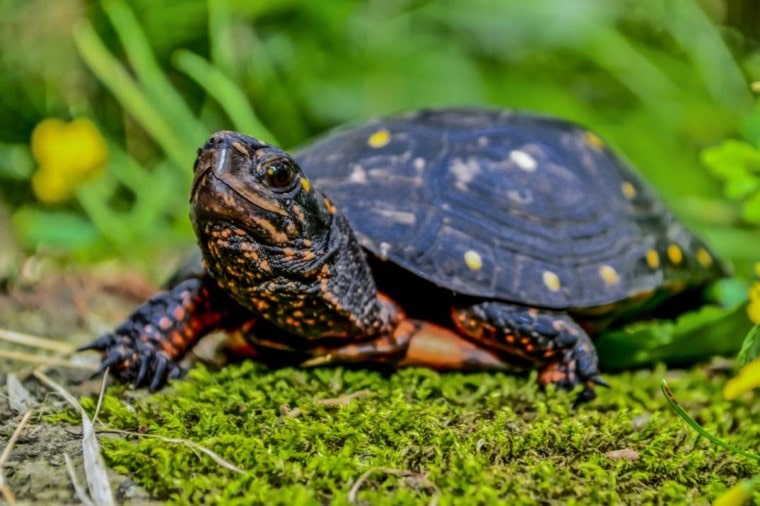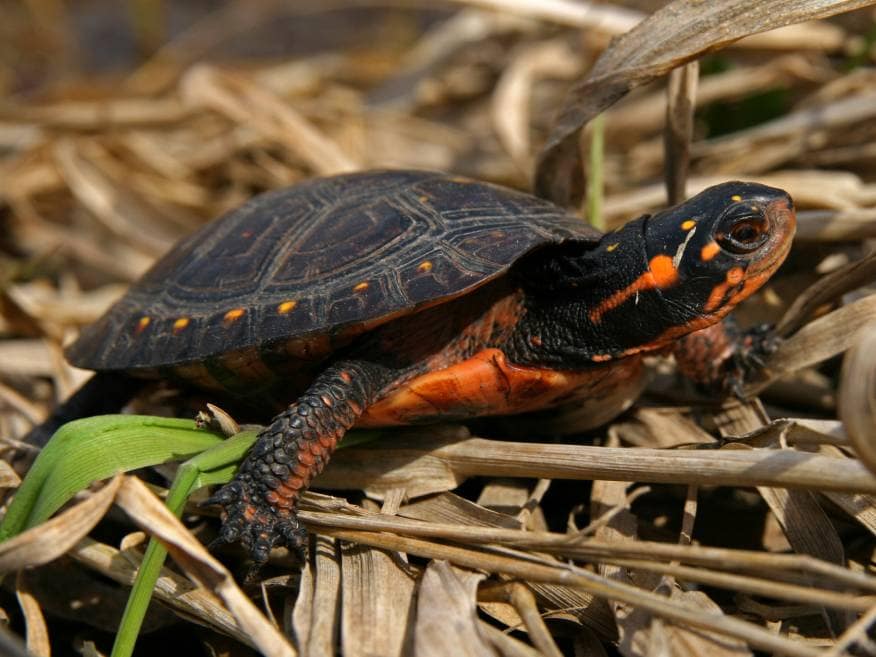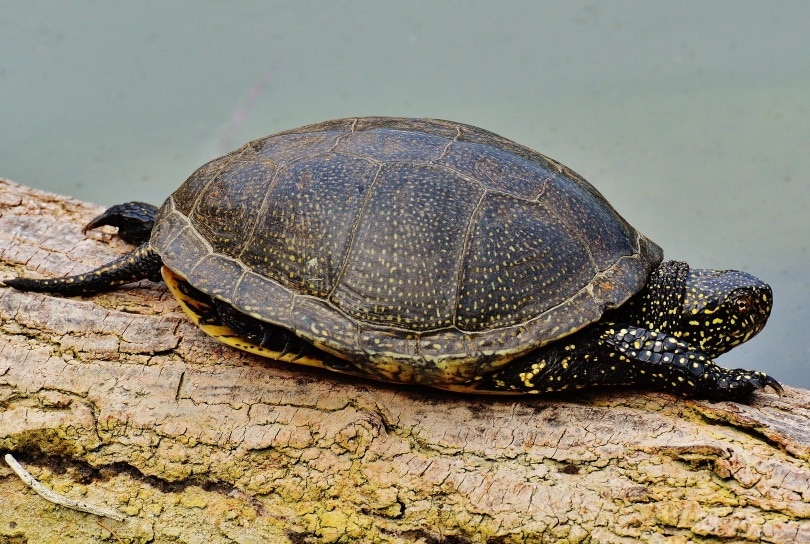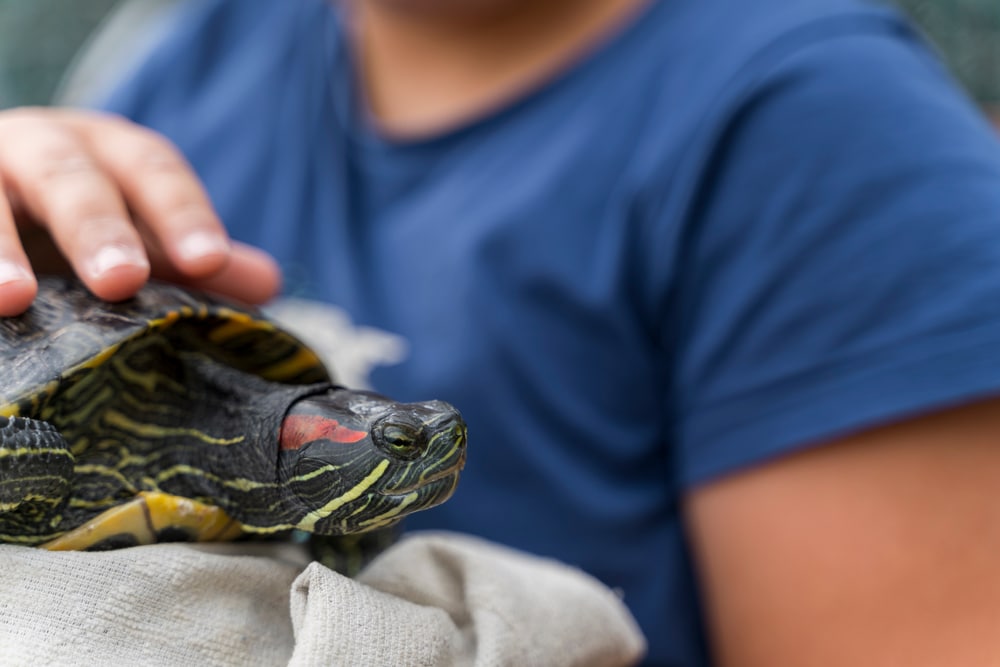
Spotted Turtles have grown in popularity as pets in recent years. They are cute, small, and fun to watch! If you have considered bringing a turtle or two into your home, these might be a good choice. They do require some specific care, but if you are willing to do the work, Spotted Turtles can bring you a lot of joy. Let’s learn some more about them and see if they are right for you!
 Quick Facts About Spotted Turtles
Quick Facts About Spotted Turtles
| Species Name: | Clemmys guttata |
| Family: | Emydidae |
| Care Level: | Medium |
| Temperature: | Basking 82 to 86 degrees Fahrenheit; water 75 to 85 degrees Fahrenheit |
| Temperament: | Active, curious |
| Color Form: | Black with yellow spots |
| Lifespan: | 20 years or more |
| Size: | 3.1 to 4.7 inches |
| Diet: | Insects, shrimp, leafy greens, fruits |
| Minimum Tank Size: | 20 gallons |
| Tank Set-Up: | 3 to 6 inches water; beach area |
| Compatibility: | Can live together with some caveats |
Spotted Turtle Overview
Spotted Turtles are native to North America. At one time, they were found widely throughout the eastern United States and Canada. Unfortunately, their population in the wild has been decimated by overharvesting and habitat destruction. Captive breeding has increased their numbers in captivity, but wild populations are still struggling in many areas.
Spotted Turtles are named for the bright yellow spots that cover their shells. These turtles are small, reaching a maximum size of 5 inches. They are semi-aquatic, meaning they need both water to swim in and dry areas to bask in. The more they mature, the less time they will spend in the water.
They can live for a very long time in captivity if properly cared for. While most will live for at least 20 years, it is not uncommon for some to live for 50 years or more!
As a pet, the Spotted Turtle is best for observing, not handling. They do not like to be touched or picked up frequently. It stresses them and can lead to health problems and unhappy turtles. They make good pets if you are just looking for turtles to observe. They are active and curious creatures.

How Much Do Spotted Turtles Cost?
You should make sure you are only buying Spotted Turtles that have been captive-bred. Their numbers in the wild have been severely lessened by overharvesting for the pet trade and they are considered endangered. Captive-bred Spotted Turtles can cost anywhere from $250 to $300. You must research the breeder and make sure you are buying a turtle that has not been taken from the wild.
Typical Behavior & Temperament
Spotted Turtles are active and curious. However, they are also very skittish and frighten easily. They do not like to be handled and will become distressed if touched or held too often.
If you leave them alone, however, they are fun to watch. You can provide them with rafts and small shells and they will play with them in their tank.
You can also generally keep these turtles together when they are young. Once they reach breeding age, you may need to separate the males and the females at feeding times.
Appearance & Varieties
The Spotted Turtle is one of the smallest species of turtles. They only reach about 5 inches in length when fully grown. The shell of the Spotted Turtle is their most distinctive feature. The shell is black with bright yellow spots sprinkled across it. They may have over 100 spots on their shell by the time they reach full maturity.
The skin of the Spotted Turtles is also black or dark grey. There are yellow spots on the head and neck, as well as on the legs. The underside of their shell is yellow or orange. Males tend to have thicker tails and black chins, while females have thinner tails and reddish skin on their chins.

How to Take Care of Spotted Turtles
Habitat, Tank Conditions & Setup
Spotted Turtles are semi-aquatic which means they spend some time in water and some time on land. In captivity, they must have the right balance of land and water space to prevent shell rot or other infections.
Tank
The minimum tank size for one Spotted Turtle is 20-gallons. However, many people will keep more than one of these tiny turtles. In this case, you will need a larger tank. It is recommended that you use at least a 75-gallon tank if you have 3 or 4 turtles together.
While they are semi-aquatic, Spotted Turtles are not great swimmers. Therefore, the water in the tank should not exceed 6 inches. Your turtles should be able to reach the surface with their heads with their toes touching the bottom.
Substrate
Your tank should be equal parts water and dry land. Sand, gravel, and soil make good land spots for your turtles to bask and dry off.
Temperature
The water temperature should be kept between 75 and 85 degrees Fahrenheit. The basking spot should be 82 to 86 degrees Fahrenheit.

Lighting
Your turtles will need two different types of lighting. First, you will have to have a heat lamp to maintain the temperature of the basking spot. Then, you must provide your turtles with UVB lighting. UVB lighting is necessary to prevent metabolic bone disorders in your turtles. You will need to change the UVB bulbs every few months to maintain effectiveness.
Plants and Decor
The Spotted Turtle can be skittish and likes to have places to hide. Hollow logs, aquatic plants, and fake plastic plants are a great way to make sure your turtles feel comfortable in their environment. Having plants and rafts in the water can help ensure your turtles are safe in the water by providing them with something to grab onto if they have trouble swimming.
Do Spotted Turtles Get Along with Other Pets?
Spotted Turtles can be kept together in tanks and will generally be fine as juveniles. Once they reach breeding age, you will want to keep an eye on them for behavioral changes. Males may chase females and bother them so much that the females stop eating. Providing separate feeding areas can help solve this problem.
Males may also become aggressive toward one another when females are involved so you will want to limit the number of male turtles in your tank.
Turtles can carry salmonella bacteria so they should be kept away from other pets. You should always wash your hands after handling your turtles to prevent illness.

What to Feed Your Spotted Turtle
Spotted Turtles are mostly carnivores, although some will also enjoy fruit and vegetables. The bulk of their diet should come from turtle pellets, minnows, shrimp, worms, snails, and crickets. If your turtle likes them, leafy greens like dandelion and collards are another great option to supplement their diet.
They can also eat some aquatic plants, zucchini, and apples. Spinach, kale, and other cabbages can bother the turtle’s stomach and should be avoided.
Adult turtles should be fed every other or every third day. A good rule of thumb is to feed them as much as they can eat in about 15 minutes. Juvenile turtles need to eat small meals a few times each day.
- You May Also Like: 10 Best Turtle Foods
Keeping Your Spotted Turtle Healthy
Maintaining a clean tank is the biggest factor in keeping your pet turtles healthy. Spotted Turtles are generally healthy and hardy, but can suffer from infections and parasites if their tank is not kept clean.
The other important factors in turtle health are lighting and temperature. They need to have enough UVB lighting for bone and shell health. The Spotted Turtle also has to have the correct temperature levels in their tank, both in the water and the air.
Breeding
The Spotted Turtle breeds in the spring, between March and May. If you have a tank with both males and females, you will want to observe them around breeding time. The males will chase the females, causing the females to become agitated and forget to eat. One way to counter this problem is to feed them in separate tanks.
The female lays between 3 and 8 eggs. These eggs will hatch in anywhere from 55 to 90 days, depending on the heat and humidity levels.
Are Spotted Turtles Suitable For You?
If you are willing to do the work to keep their tanks clean and temperature-controlled, then a Spotted Turtle might be a good pet for you. They are small, active, and curious creatures that are fun to watch. They don’t like a lot of handling, so if your family has small children you will want a different pet. However, for older children and adults who want to observe, these cute little turtles are a good choice.
Featured Image Credit: Jay Ondreicka, Shutterstock

 Quick Facts About Spotted Turtles
Quick Facts About Spotted Turtles





